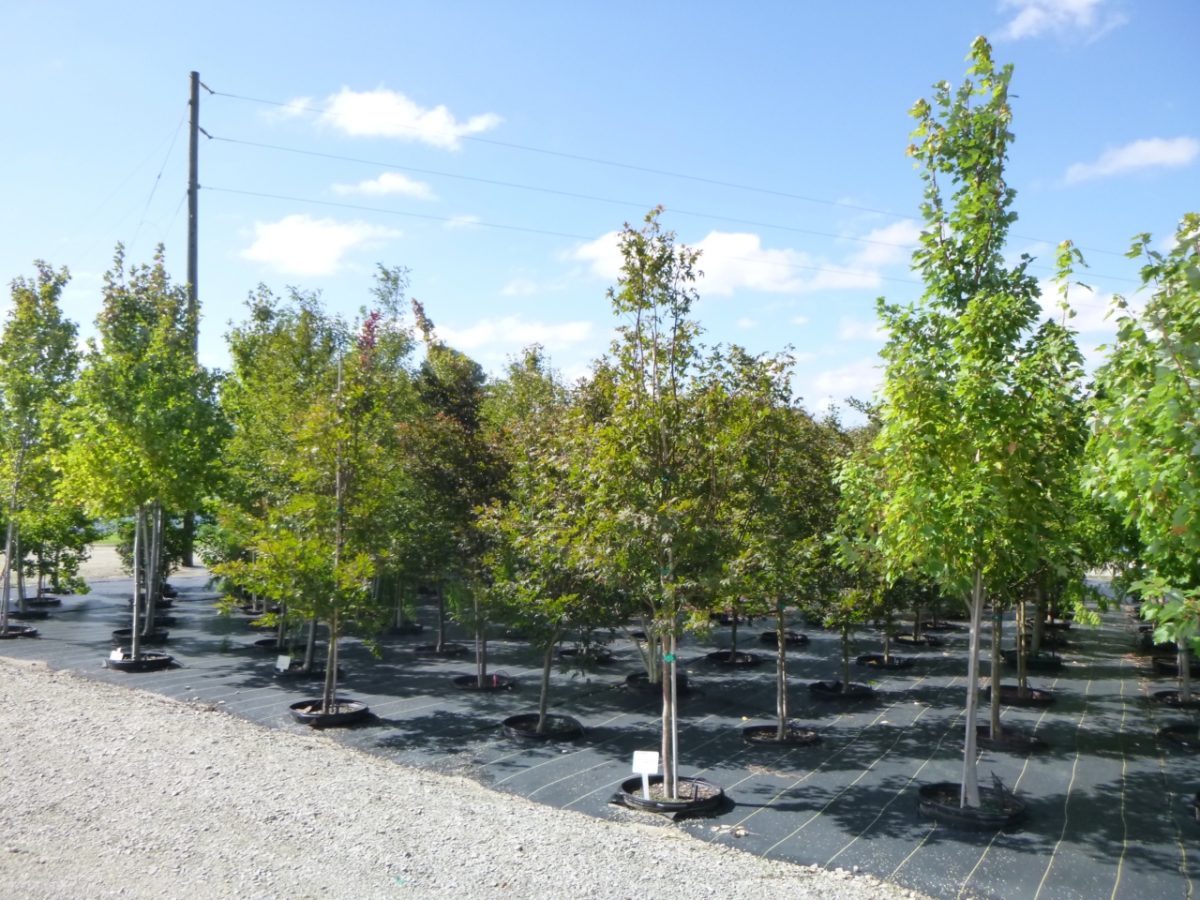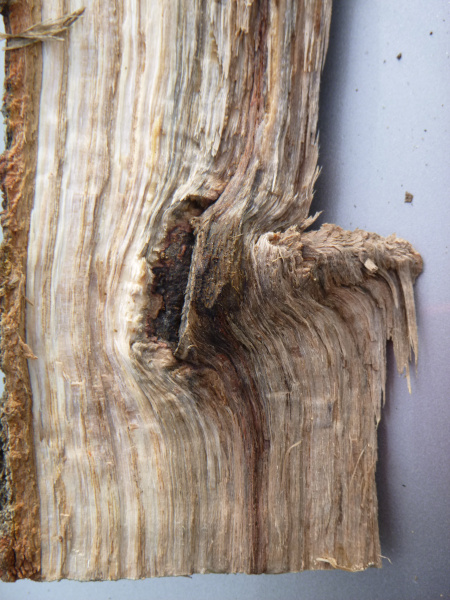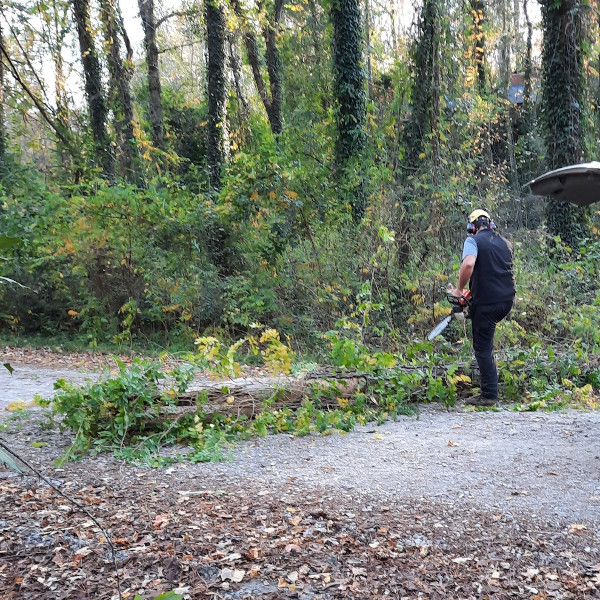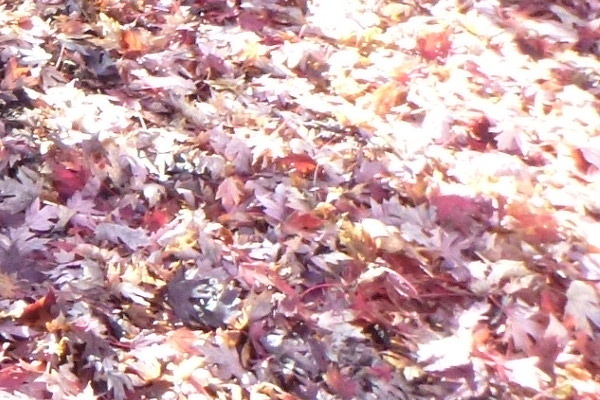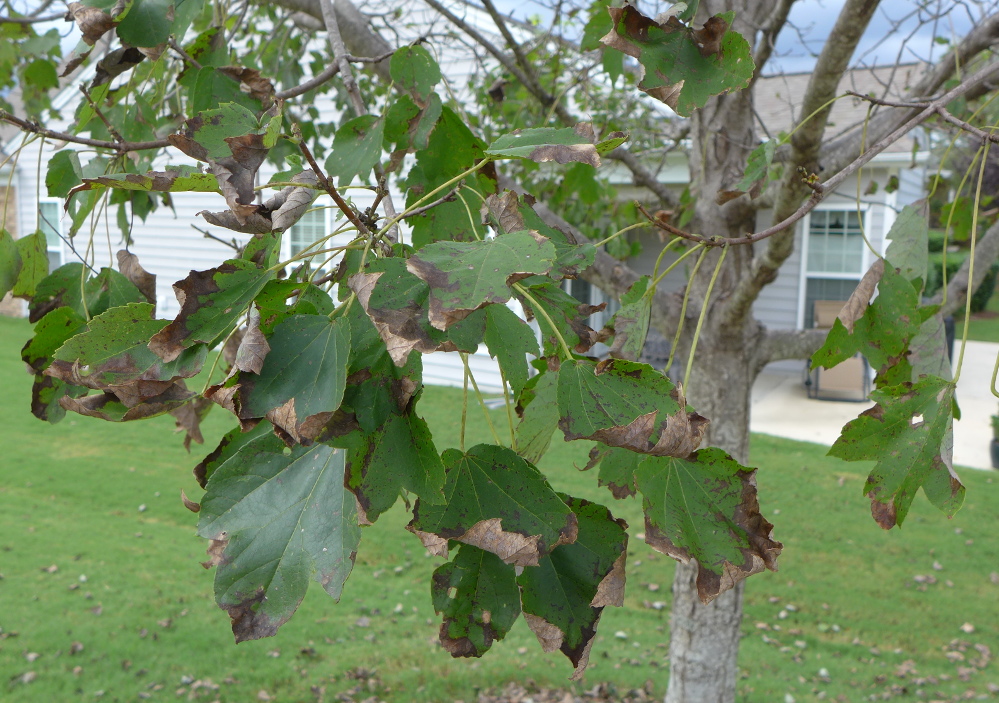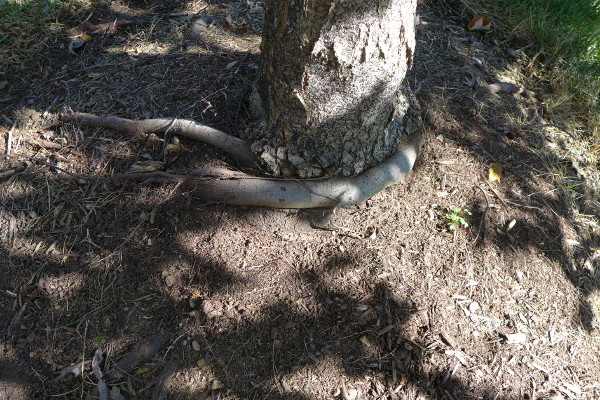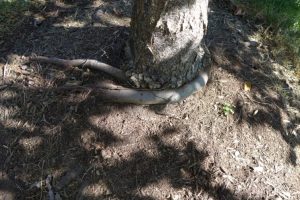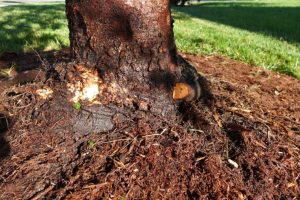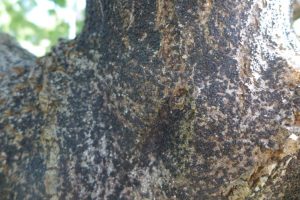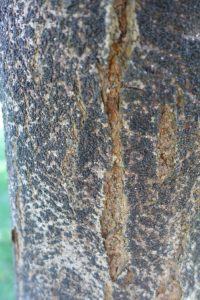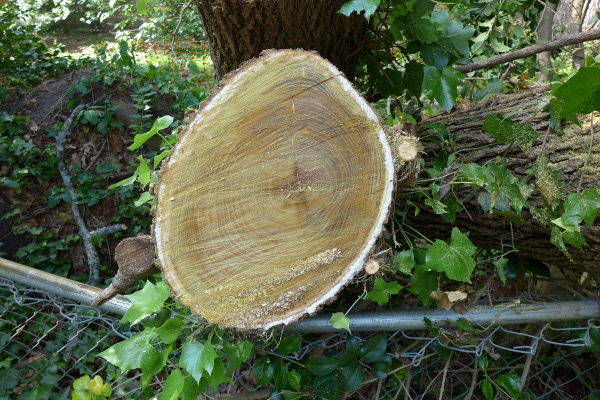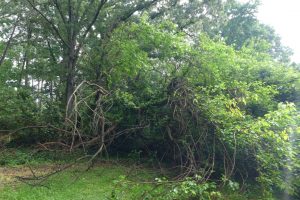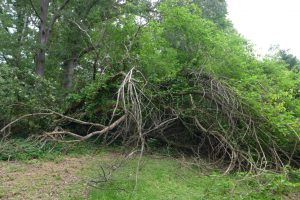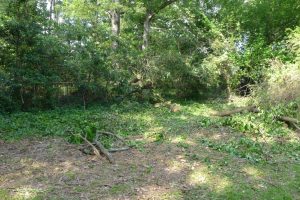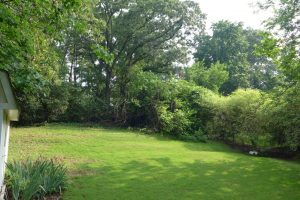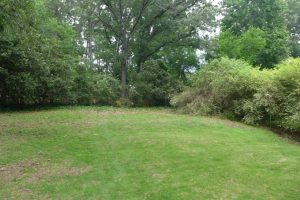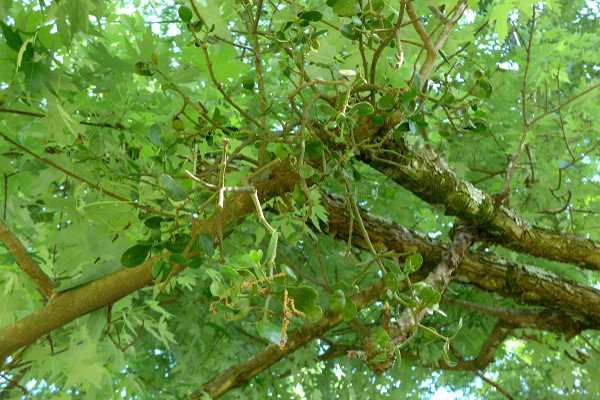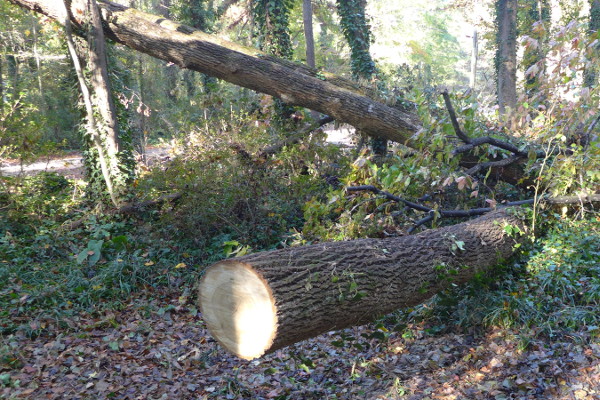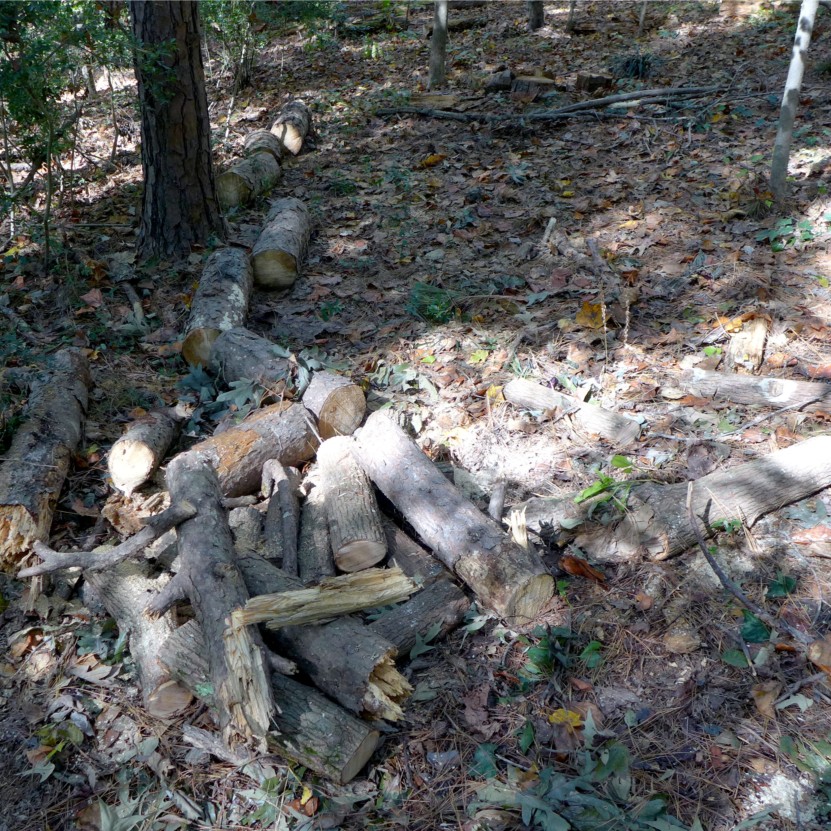To my customers – thank you. I look forward to another year of planting, pruning, and the occasional removal.
Category: Stories
Merry Christmas & Happy New Year
Merry Christmas and Happy New Year 2023. Thank you all for your patience in working with my schedule late last year.
(Image: A pruned branch on a oak tree shows up years later after the tree is removed in a cross section of the wood. Note the dark area up and down from the cut area as well as the seashell shape behind the branch showing the branch increasing in size each year)
Merry Christmas & Happy New Year
Thank you to all my customers for the work in 2021.
(Photo) Oak stump marked by 811 utility locating before grinding.
Merry Christmas & Happy New Year
Merry Christmas and a Happy New Year to all my customers. Thank you again for trusting me to remove, prune, plant and care for your trees.
Image: Just as I walked up to ring the door of one my last jobs of the year, a large dead pine tree fell across the street leading up to that customer’s driveway. It had been held up long past its due date with thick wisteria vines. I cut it up and, with a couple neighbors, moved it out of the road.
Merry Christmas & Happy New Year
Merry Christmas and a Happy New Year to all my customers. It was another year of hard work for excellent customers and it has been my satisfaction to drive past trees that I’ve planted on more and more roads.
Thank You
To everyone that hired my services this past year – thank you. The next couple months will bring pruning and removals and a chance to see people again. Before Christmas, I spoke with a farmer who talked about the wet weather making it difficult for several of his crops. I saw some of that in the world of trees in 2018: sites that couldn’t be worked on for stretches because the lawns wouldn’t take even foot traffic, and a surprise of Anthracnose in Maple trees in late August/September due to the many damp and cloudy days. Sometimes it takes a little extra time or a little extra research, but problems can be solved.
If you have a tree problem, please contact me.
Maple On A Roof in Raleigh
A customer that I had worked for previously called me to come see if I could remove a large Maple tree that had fallen onto his roof during a recent snowstorm. The snow turned out to just be the last straw, as the trunk near the base was quite decayed and the tree had already developed a lean searching for sunlight over the driveway.

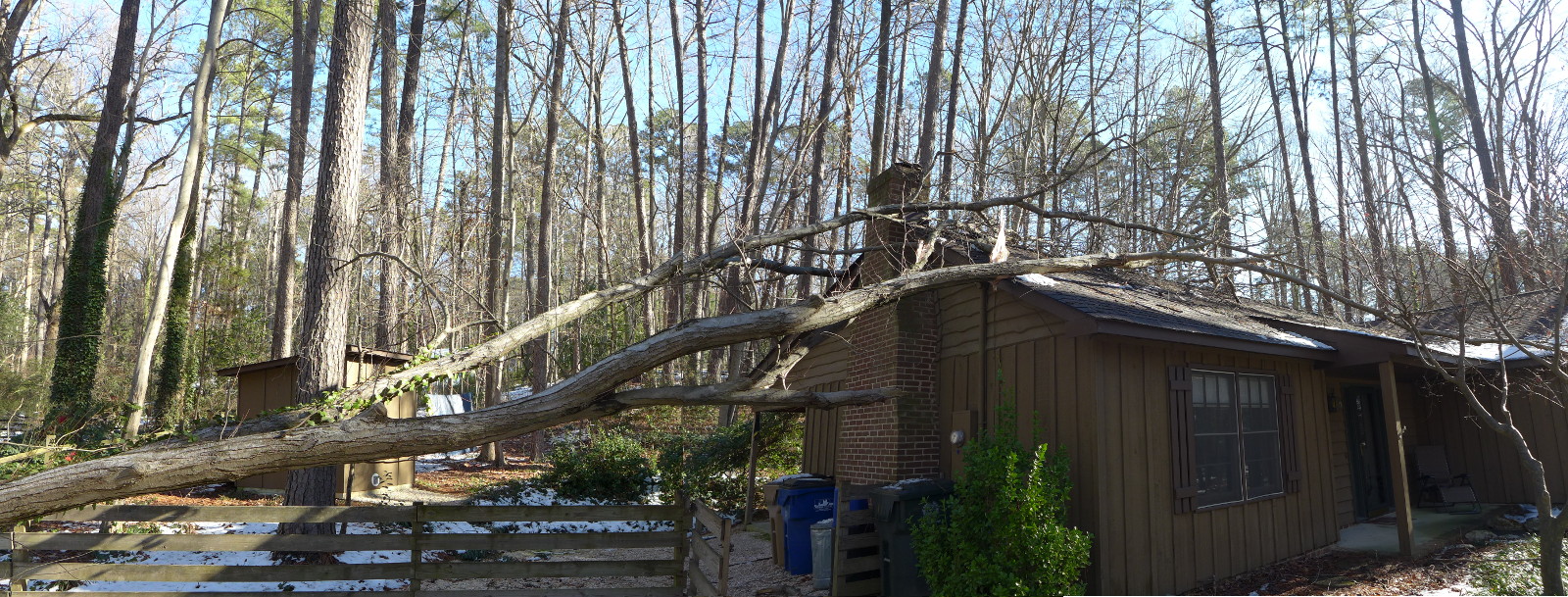
A number of factors allowed me to do this job. His home has a roof pitch of 3:12 in the back and 4:12 in the front and the drop off to the ground if just a few feet into soft ground on the rear and not much more in the front. The tree was also supported on the edge of the roof at a few points, so all the branches on the roof could be cleared off before removing the tree from the roof. There was still some snow on the roof when I started, so I brought a broom up with me to clear out a walkway ahead wherever I cleared branches.
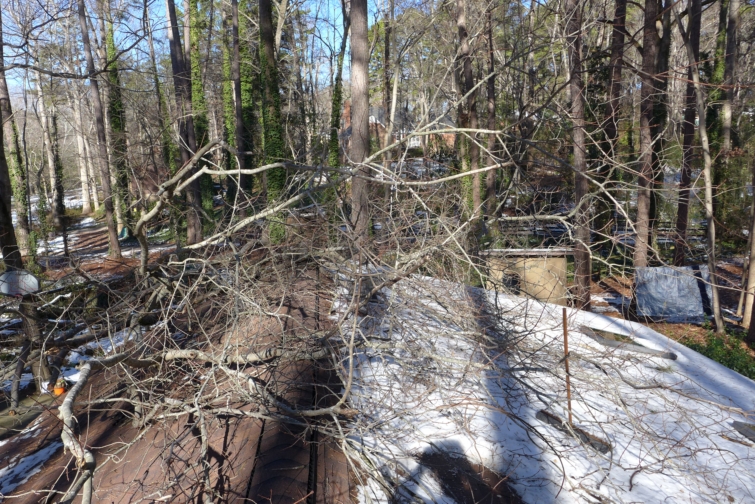
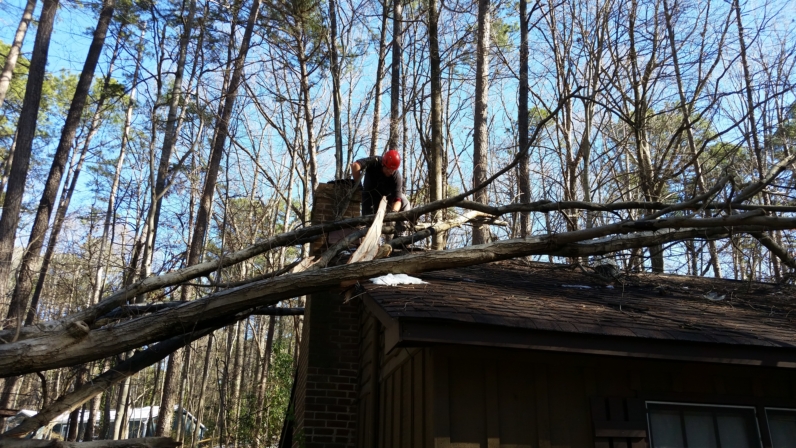
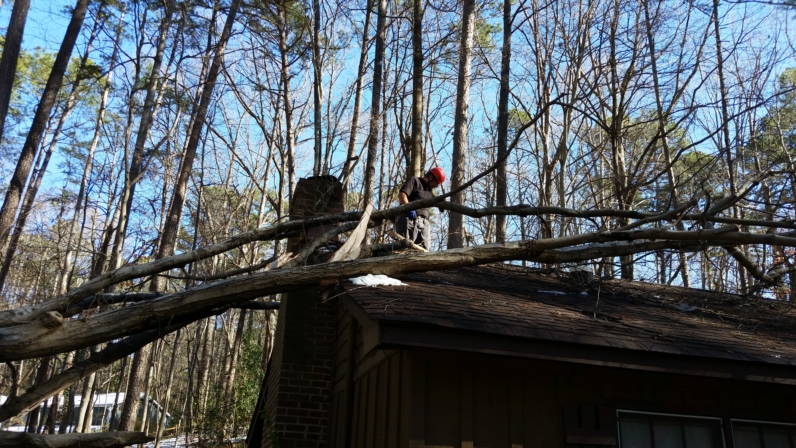
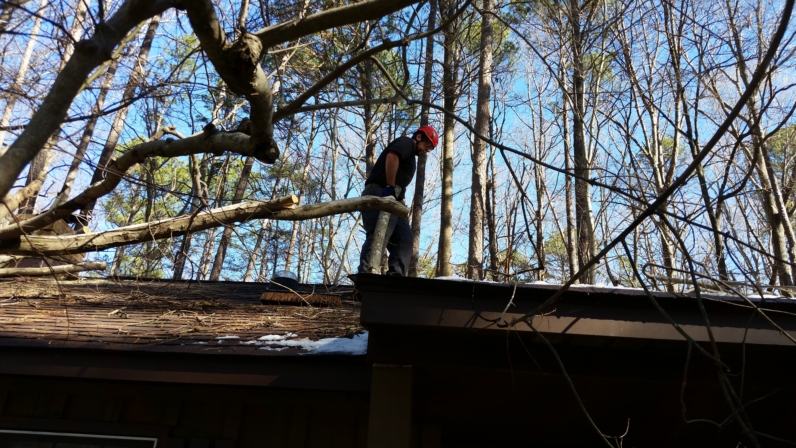
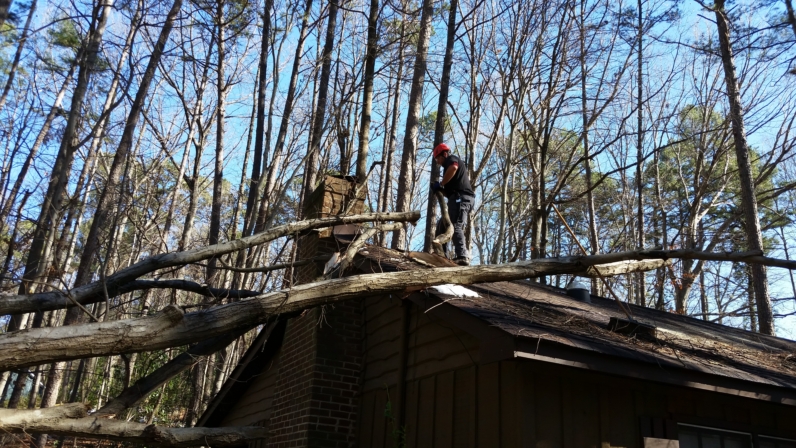
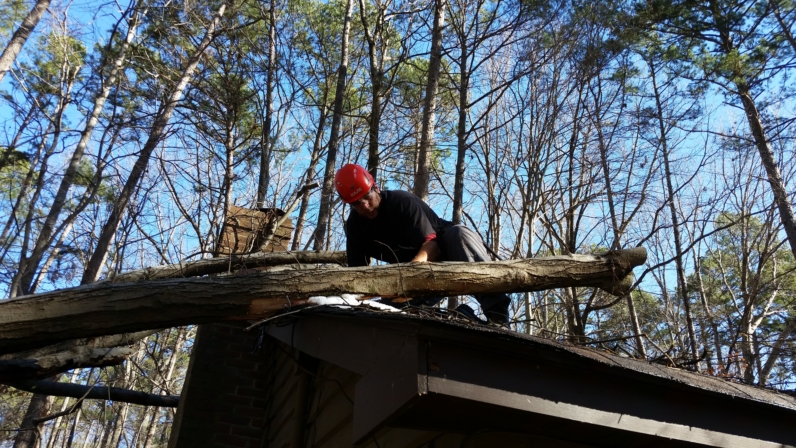
The tree was secured with a rope to prevent it from sliding off the front of the roof. Sliding like this could have caused more damage to the roof and smaller branches could clip parts of the building under the roof line. A second rope was placed to take a little of the weight off the roof, but the acute angle minimized the help.
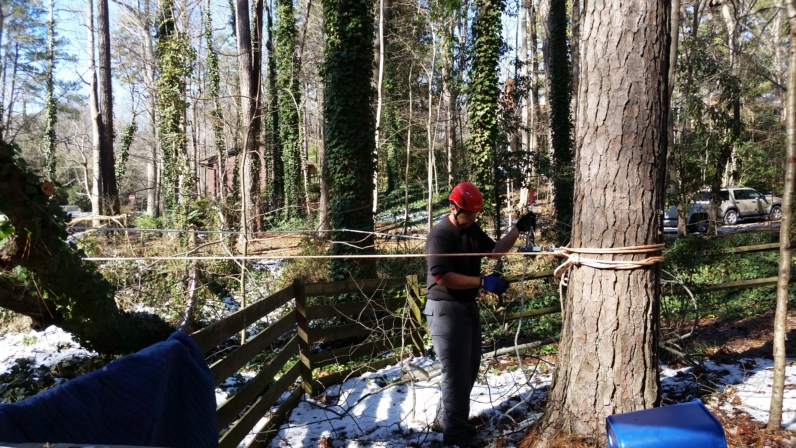
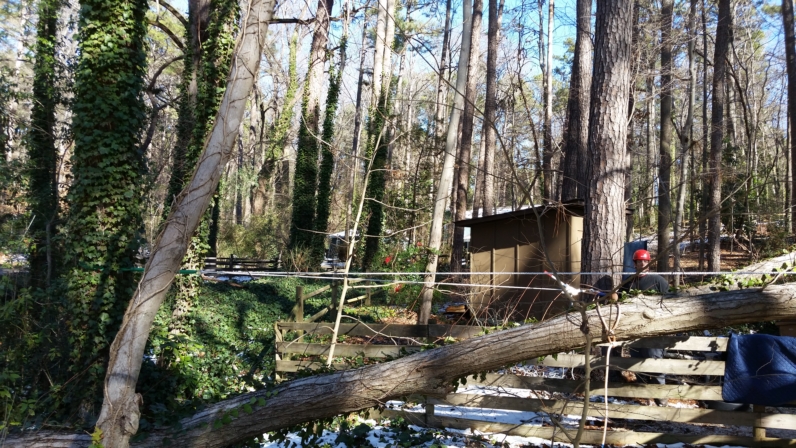
Once all the branches had been reduced to their contact points on the edge of the roof, the work started from the ground. The pressure was taken off to leave the main branch on the roof at last, getting down everything else to prevent damage to the fence. The main trunk had a second trunk of some size. I cut it off near the base of the tree and then cut off sections from that end, working the limb down in size. Eventually, I was able to carry off the branch from the roof.
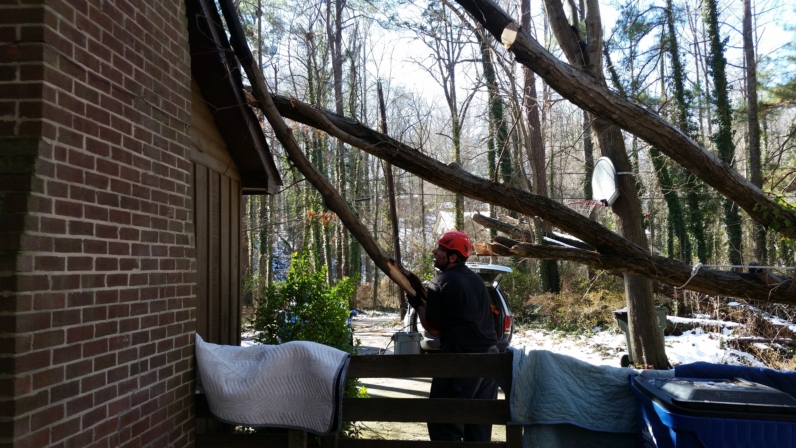
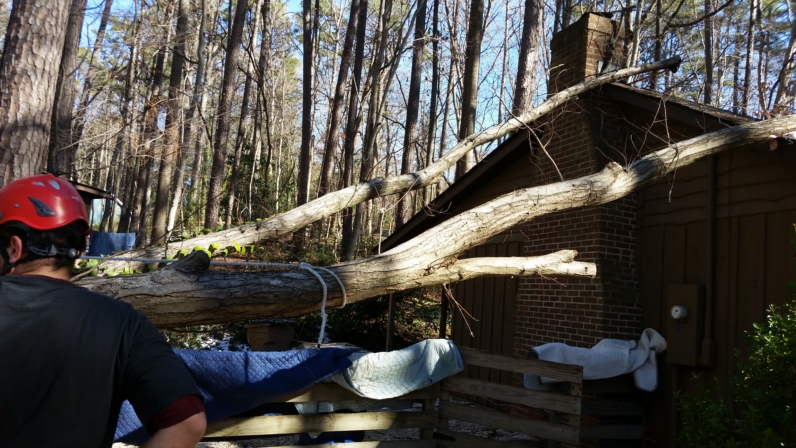
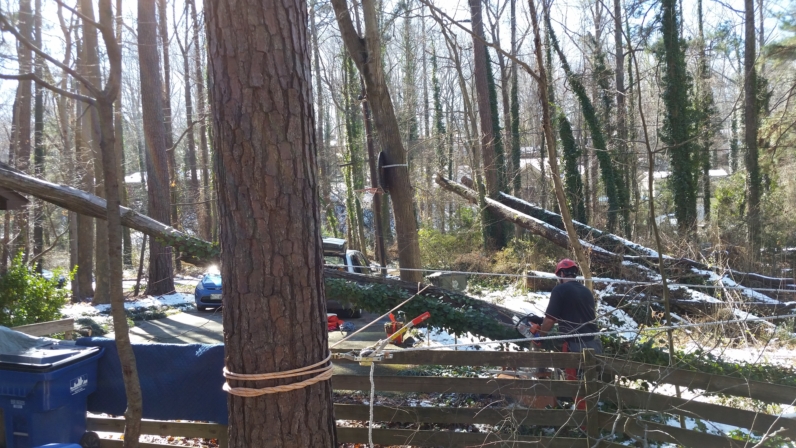
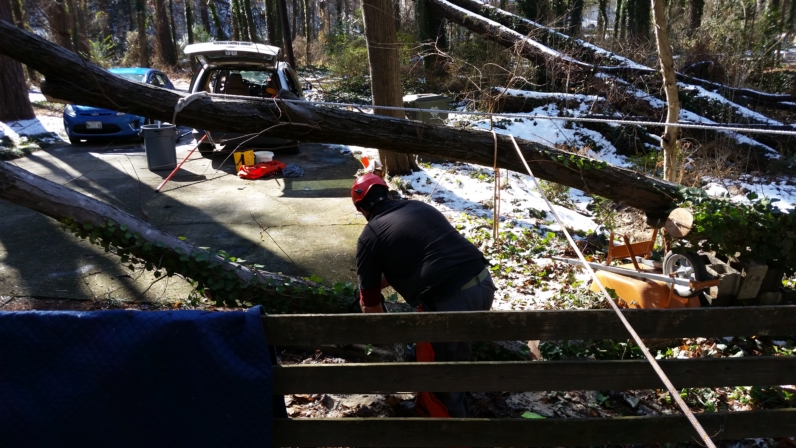
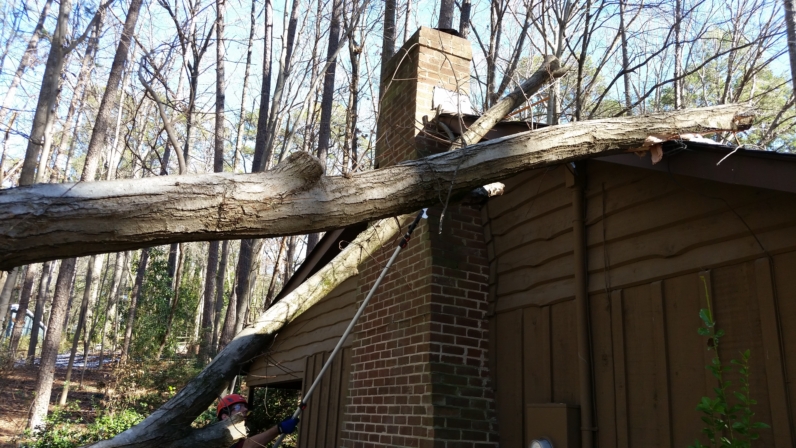
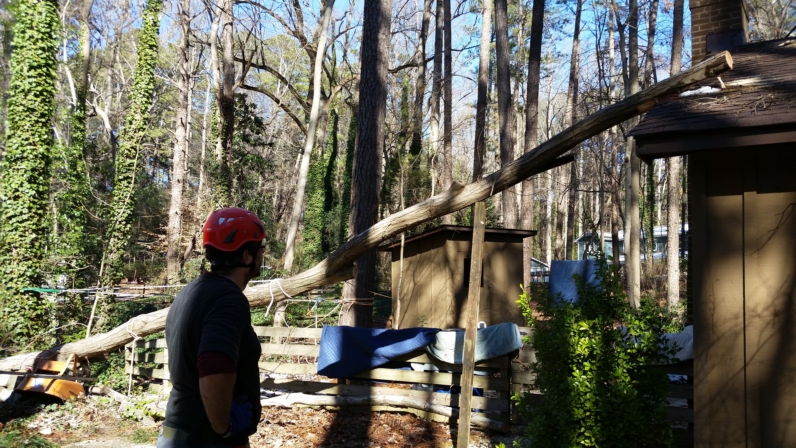
To get enough weight off the final piece, a 4×4 was hammered in place, the end cut most of the way through by the roof, the trunk cut most of the way through closer to the stump end like the previous limb, and then the end on the roof was cut off and the piece resting on the 4×4 pulled forward.
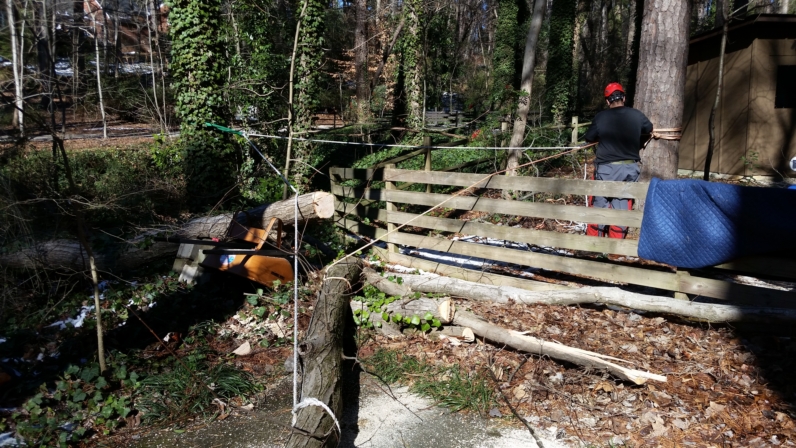
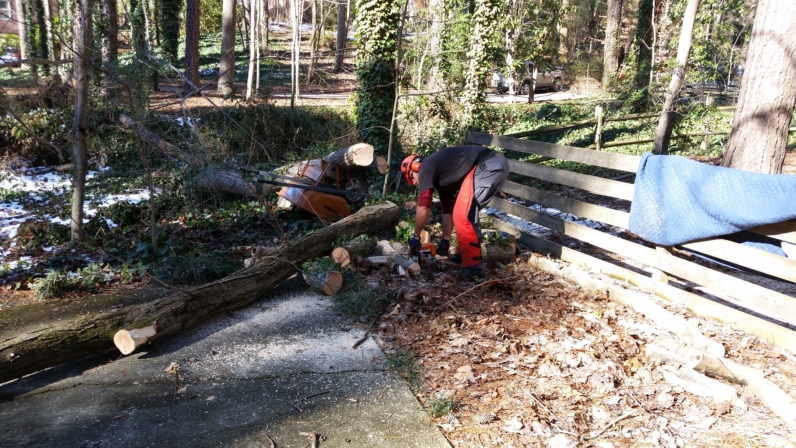

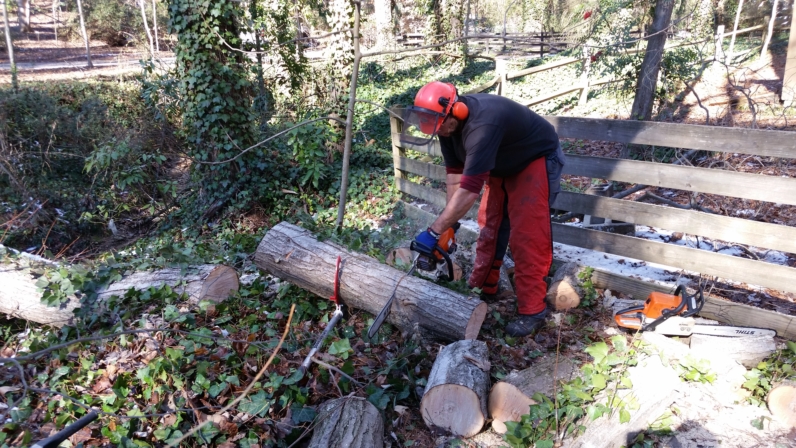
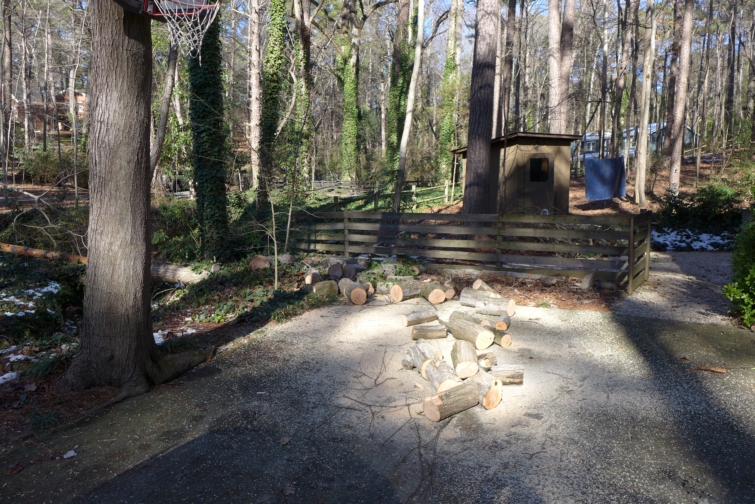
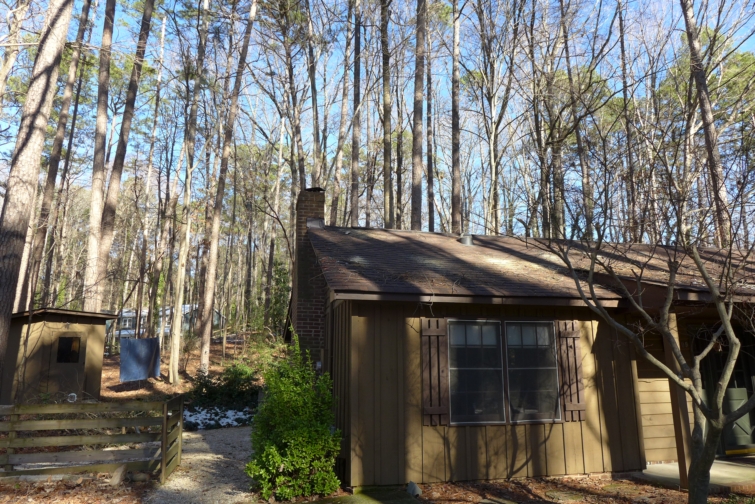
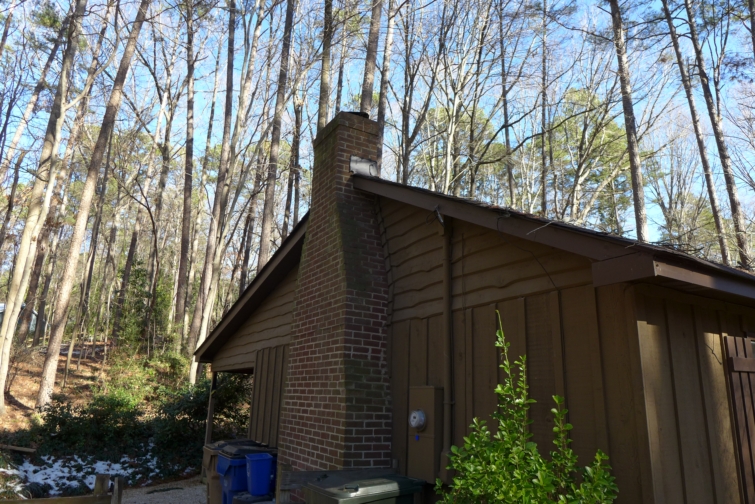
The customer requested the wood be bucked so he could split it and burn it, so that was the last part. Once finished, he graciously offered to blow off the roof and driveway for me so I was able to clean up my equipment and go.
Maple in Cary – Insect and Root Problems

Late last year a man contacted me through the website with pictures of a maple tree in his front yard. The problems weren’t obvious looking at the pictures, but the man indicated the tree didn’t look right. In person, it became clear that the tree had a poor form given relatively good conditions as far as room and light in the nearby area. The tree had a large branch coming out across the driveway that was growing more quickly than the main trunk. This tree would develop into an ugly, lopsided tree with time.
Looking closely at the root flare, where the trunk meets the ground, I found a girdling root that if not causing problems then, would soon cause problems for a tree that didn’t need any more of them. The root wasn’t too large compared to the trunk, so I decided it was best to cut it away.
One other observation stood out during the close inspection – the trunk of the maple was nearly black. Black because nearly the entire maple was covered densely in Gloomy Scale, Melanaspis tenebricosa. Gloomy scale is a sucking, armored insect that takes nutrients from the tree. With this much on the tree, it was no suprise to see the sparse canopy.
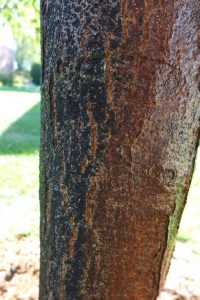
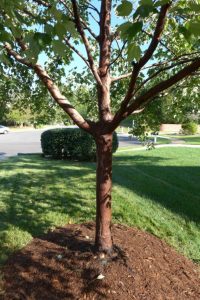
After some research, I decided on a plan of removing as many scale as possible on the lower portion of the maple, treating with a horticultural oil in the late winter on the thinner upper canopy, and giving the maple the best possible growing conditions by extending out the mulch circle to reduce competition with the lawn.
Finishing The Job
I completed the removal of a dead Crape Myrtle recently and I was surprised to hear a now familiar story: “We had a man come out to do the job, but his chainsaw broke and then he didn’t come back.” I examined the cut and it was small enough that it could have been finished with a handsaw and effort. Why didn’t he?
Of the many times I’ve heard this story, some cases might be a person who takes the money and runs, but some are surely just leaving work on the table. In any case, I finished up the work left unfinished and was happy to do so. Sometimes the breadth of characters in the world surprises.
Mulberry In Raleigh
A customer contacted me about a Mulberry that had fallen down due to the heavy rains received in the previous days. In one of the established neighborhoods in the North Hills area of Raleigh, the Mulberry had been growing for a long time and providing privacy along a rear fence. And had it ever!
Mulberries are tremendous growers that put up multiple trunks and produce a lot of wood. Unlike a Bradford Pear, the wood is quite strong and so the Mulberry grows easily to an unbalanced shape as it seeks light. This tree was probably under 40 feet tall when standing, but nearly as wide, and was close to 2 feet in diameter at waist height.
The thing with storm fallen trees is that they are over, but they are not down. So the work is nearly as much, and in many cases more, than cutting a tree down from a standing position. The tree was pieced down carefully from the tips, working back, making sure to be careful of the shifting and rotating weight that is released from storm fallen wood.
In the end, the trunk was cut back close to the root mound and left as shown per the customer’s request. It measured over 24 inches at this point. You can also see the yellow wood and white sap that are hallmarks of Mulberry.
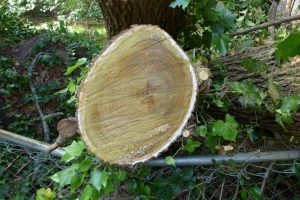
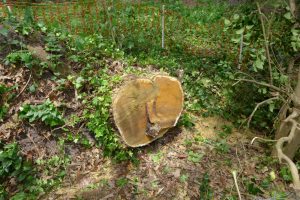
Disposal went well, the location wasn’t close to the street, but the land sloped down – a welcome relief. Because I don’t use heavy equipment and I work carefully, the yard was left in great condition despite moving a couple tons of tree across it.
Merry Christmas & Happy New Year
Merry Christmas and Happy New Year to my customers. Whether you just had me out for an estimate or gave me the job, I enjoyed meeting so many this year. As my brother-in-law says about his business, “I have the best customers!” The only headaches this year were a few 95F/90% humidity days, a stuck tree that took all my coaxing to come down, and a split pair of pants. With a business that focuses on small trees, what suffered most was the wedges.
2016 Annual Report
- Animals Rescued: 2 baby squirrels (Thank you, Wildlife Welfare)
- Lost Tools: 1 Silky handsaw
- Vehicles Stuck In Mud: 1
- Vehicle Tire Flats: 1, shredded on Dogwood stump
- Shovel Handles Broken: 3
- Dogs Met: 4, only 1 hostile
- Tyvek Suits Worn: 1, severe poison ivy on tree
- Favorite Job: Mulberry Removal
- Toughest Job: Hickory hung up in an Elm and a Magnolia. Save the Magnolia.
- Furthest Job Location: Middlesex, NC
- Most Shrubs Removed on One Job: 21
- Hardest Plant ID: Ternstroemia gymnanthera. Great plant, I recommend using it where conditions permit.
Log Bucking in Raleigh
A customer had me out to remove a dead pine tree, broken & hung-up, that was in danger of collapsing onto his home. That worked completed, he had me back out a week later to buck up all of the fallen wood on his property.
Log bucking is simply cutting wood into shorter lengths that can later be split for firewood or used in outdoor fire pits. Generally the lengths are from 12 to 16 inches, depending. I don’t do splitting. I do stack, but the customer didn’t want that in this case.
Thanks to the more powerful equipment I use and the tools I have for handling timber I was able to cut up everything on his lot in 2.5 hours. In all I bucked Oak ranging from 6 to 12 inches in diameter, Pine from 4 to 16 inches, and large Tulip Poplar up to 22 inches that had fallen in a storm. When you have many fallen trees and a small chainsaw, it can save you many, many hours to use the log bucking service I offer.

